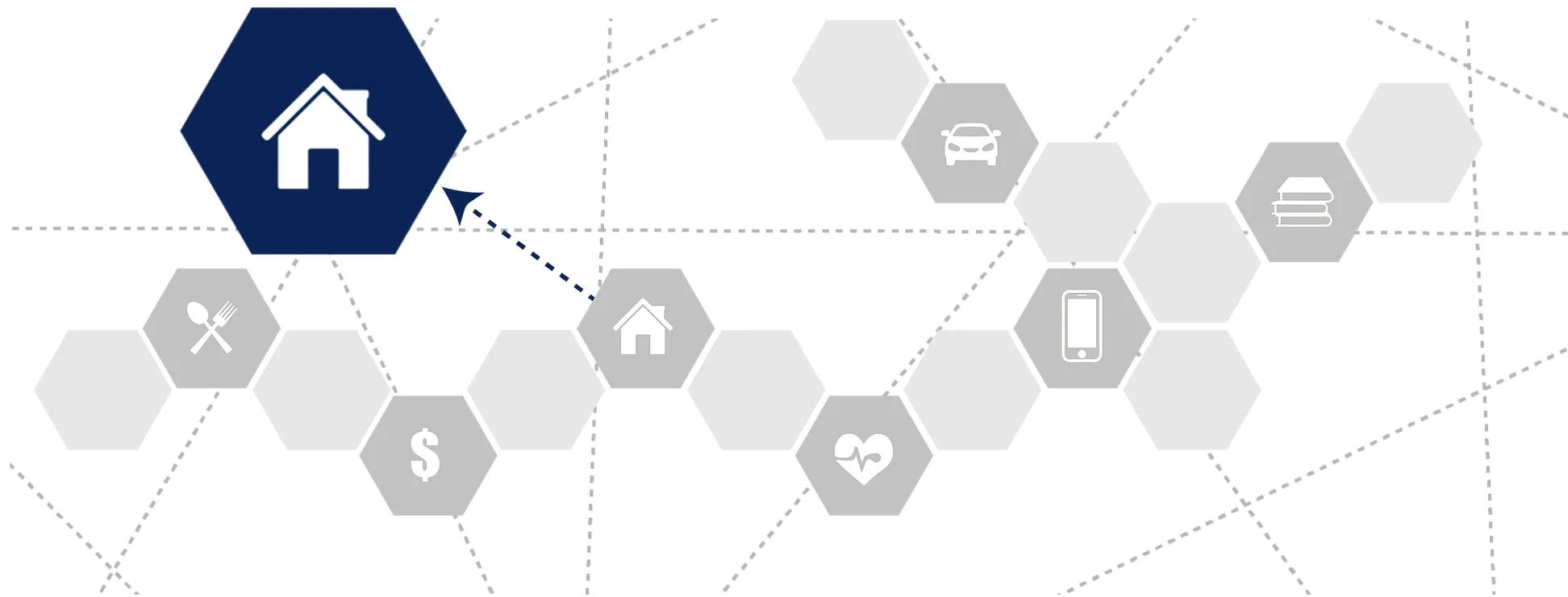
|
Housingclick to view |

|
Health Careclick to view |

|
Child Care and Educationclick to view |

|
Technologyclick to view |

|
Foodclick to view |

|
Taxesclick to view |

|
Transportationclick to view |
||
Broader Costs of Affordable Housing
When ALICE households pay too much for housing or make other choices that compromise their living situation or financial stability, communities feel the impact both economically and socially:
- The local economy suffers because ALICE families have less to spend on other goods and services in the community. They may also not have enough resources to maintain their homes, which impacts entire neighborhoods.
- When poor housing causes health problems, communities incur higher costs. Poor-quality housing, as well as living in unsafe neighborhoods or having long commutes, can cause serious health problems for residents. Treating chronic health issues raise health care and coverage costs for all.46
- More traffic is created when affordable housing is located far from jobs, leading to increased wear and tear on roads, higher costs for road maintenance, and an increased likelihood of accidents and delays, which affect all commuters.
- Long commutes reduce worker productivity and performance, as well as reducing new hire retention. This in turn affects co-workers and customers, impacting the business bottom line and state economic competitiveness.47
- As families move farther away from urban centers, taxpayers incur higher costs because the resulting suburban development requires additional infrastructure and services such as roads, public transit, and sewage. It is estimated that urban sprawl costs the U.S. economy more than $1 trillion per year.48
- Run-down housing affects neighborhoods. Housing units that have not been maintained add public safety risks and detract from the appearance of public spaces.49
- Homes in foreclosure impose costs on neighborhoods and local government agencies, reducing property values for neighbors and increasing costs for the whole community. Neighbors of foreclosed-on homes lose value in their home, with higher loss rates in neighborhoods of color. Foreclosures are also bad for many local banks, as both lenders and investors lose money on them.50
- Communities bear the cost of caring for homeless families. Chronic homelessness for one person is estimated to cost taxpayers as much as $30,000 to $50,000 per year.51 New York City, with the nation’s largest sheltered homeless population, spent $1.3 billion on services to the homeless between July 2015 and June 2016.52 These costs are much greater than the cost of preventing homelessness: It costs four times less to house homeless people than to provide them with temporary services, with more savings for housing those with severe physical or mental health issues.53
Sources
46
American Hospital Association. (2016, December). American Hospital Association uncompensated hospital care cost fact sheet. Retrieved from http://www.aha.org/content/16/uncompensatedcarefactsheet.pdf
Joint Center for Housing Studies of Harvard University. (2016). Projecting trends in severely cost-burdened renters: 2015–2025. Retrieved from https://s3.amazonaws.com/KSPProd/ERC_Upload/0100886.pdf
Maqbool, N., Viveiros, J., & Ault, M. (2015, April). The impacts of affordable housing on health: A research summary. Center for Housing Policy. Retrieved from https://www.rupco.org/wp-content/uploads/pdfs/The-Impacts-of-Affordable-Housing-on-Health-CenterforHousingPolicy-Maqbool.etal.pdf
47
van Ommeren, J., & Gutierrez-i-Puigarnau, E. (2011, January 11). Are workers with a long commute less productive? An empirical analysis of absenteeism. Regional Science and Urban Economics, 41(1), 1–8. Retrieved from http://www.sciencedirect.com/science/article/pii/S0166046210000633
Sullivan, J. (2015, April 21). How commute issues can dramatically impact employee retention. Retrieved from TLNT: https://www.tlnt.com/how-commute-issues-can-dramatically-impact-employee-retention/
48
Trubka, R., Newman, P., & Bilsborough, D. (2010, April). The costs of urban sprawl — Infrastructure and transportation. Environment Design Guide. Retrieved from https://www.crcsi.com.au/assets/Resources/b6e1625f-d90b-433d-945a-6afeff2e42f6.pdf
49
Immergluck, D. (2015, September 1) The cost of vacant and blighted properties in Atlanta: A conservative analysis of service and spillover costs. Final Report. Prepared for the City of Atlanta. Retrieved from http://45tkhs2ch4042kf51f1akcju.wpengine.netdna-cdn.com/wp-content/uploads/2016/02/Cost-of-Vacant-and-Blighted-Properties-in-Atlanta.pdf
Cui, L., & Walsh, R. (2014, October). Foreclosure, vacancy and crime (Working Paper No. 20593). National Bureau Of Economic Research. Retrieved from http://www.nber.org/papers/w20593.pdf
de Leon, E., & Schilling, J. (2017, April). Urban blight and public health. Urban Institute. Retrieved from https://www.urban.org/sites/default/files/publication/89491/2017.04.03_urban_blight_and_public_health_vprn_report_finalized.pdf
50
Apgar, W. C., Duda, M., & Gorey, R. N. (2005, February 27). The municipal cost of foreclosures: A Chicago case study. Homeownership Preservation Foundation. Retrieved from http://www.issuelab.org/resources/1772/1772.pdf
Center for Responsible Lending. (2013). 2013 Update: The spillover effects of foreclosures. Retrieved from https://www.responsiblelending.org/research-publication/2013-spillover-costs-foreclosure
51
United States Interagency Council on Homelessness. (2017). Ending chronic homelessness in 2017. Retrieved from https://www.usich.gov/resources/uploads/asset_library/Ending_Chronic_Homelessness_in_2017.pdf
52
New York City Department of Homeless Services. (2016). Mayor's management report. Retrieved from http://www1.nyc.gov/assets/operations/downloads/pdf/mmr2016/dhs.pdf
53
National Alliance to End Homelessness. (2015, June 30). Permanent supportive housing cost study map. Retrieved from http://www.endhomelessness.org/library/entry/cost-savings-withpermanent-supportive-housing

